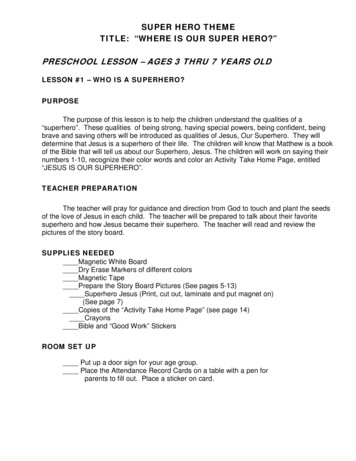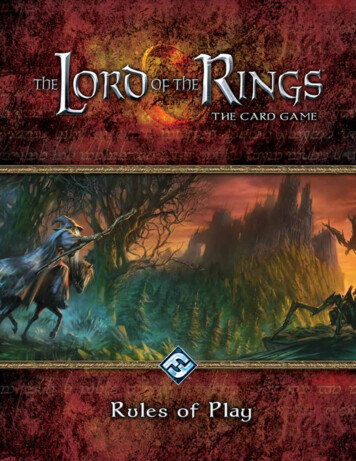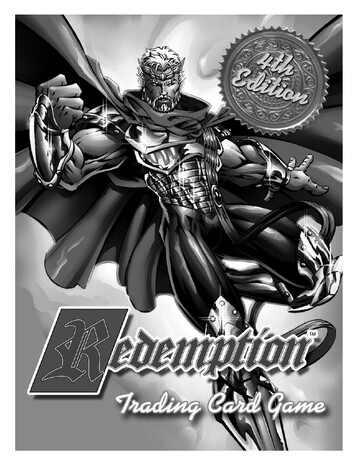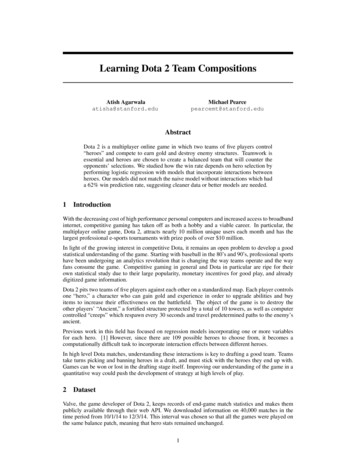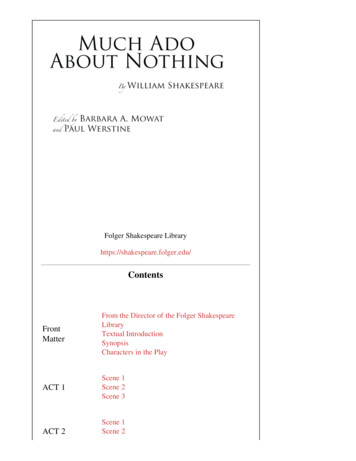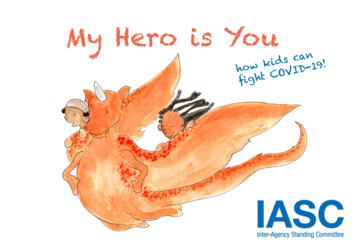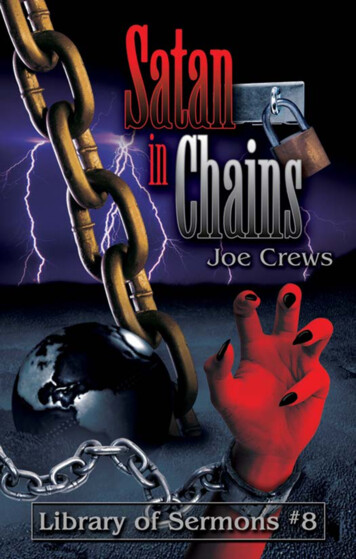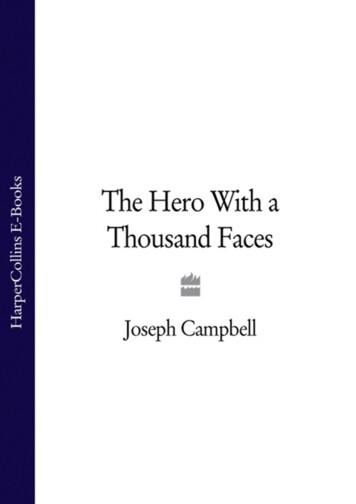
Transcription
JOSEPH CAMPBELLThe Hero With aThousand Faces2
To my father and mother3
PREFACE“The truths contained in religious doctrines are after all so distortedand systematically disguised,” writes Sigmund Freud, “that the mass ofhumanity cannot recognize them as truth. The case is similar to whathappens when we tell a child that new-born babies are brought by thestork. Here, too, we are telling the truth in symbolic clothing, for weknow what the large bird signifies. But the child does not know it. Hehears only the distorted part of what we say, and feels that he has beendeceived; and we know how often his distrust of the grown-ups and hisrefractoriness actually take their start from this impression. We havebecome convinced that it is better to avoid such symbolic disguisings ofthe truth in what we tell children and not to withhold from them aknowledge of the true state of affairs commensurate with theirintellectual level.”1It is the purpose of the present book to uncover some of the truthsdisguised for us under the figures of religion and mythology by bringingtogether a multitude of not-too-difficult examples and letting the ancientmeaning become apparent of itself. The old teachers knew what theywere saying. Once we have learned to read again their symboliclanguage, it requires no more than the talent of an anthologist to lettheir teaching be heard. But first we must learn the grammar of thesymbols, and as a key to this mystery I know of no better modern toolthan psychoanalysis. Without regarding this as the last word on thesubject, one can nevertheless permit it to serve as an approach. Thesecond step will be then to bring together a host of myths and folk talesfrom every corner of the world, and to let the symbols speak forthemselves. The parallels will be immediately apparent; and these willdevelop a vast and amazingly constant statement of the basic truths bywhich man has lived throughout the millenniums of his residence on theplanet.Perhaps it will be objected that in bringing out the correspondences Ihave overlooked the differences between the various Oriental and4
Occidental, modem, ancient, and primitive traditions. The sameobjection might be brought, however, against any textbook or chart ofanatomy, where the physiological variations of race are disregarded inthe interest of a basic general understanding of the human physique.There are of course differences between the numerous mythologies andreligions of mankind, but this is a book about the similarities; and oncethese are understood the differences will be found to be much less greatthan is popularly (and politically) supposed. My hope is that acomparative elucidation may contribute to the perhaps not-quitedesperate cause of those forces that are working in the present world forunification, not in the name of some ecclesiastical or political empire,but in the sense of human mutual understanding. As we are told in theVedas: “Truth is one, the sages speak of it by many names.”For help in the long task of bringing my materials into readable form,I wish to thank Mr. Henry Morton Robinson, whose advice greatlyassisted me in the first and final stages of the work, Mrs. Peter Geiger,Mrs. Margaret Wing, and Mrs. Helen McMaster, who went over themanuscripts many times and offered invaluable suggestions, and mywife, who has worked with me from first to last, listening, reading, andrevising.J. CNew York CityJune 10, 19485
CONTENTSCoverTitle PagePREFACEPROLOGUE: THE MONOMYTH1. Myth and Dream2. Tragedy and Comedy3. The Hero and the God4. The World NavelPART I: THE ADVENTURE OF THE HEROCHAPTER I: DEPARTURE1. The Call to Adventure2. Refusal of the Call3. Supernatural Aid4. The Crossing of the First Threshold5. The Belly of the WhaleCHAPTER II: INITIATION1. The Road of Trials2. The Meeting with the Goddess3. Woman as the Temptress4. Atonement with the Father5. Apotheosis6. The Ultimate Boon6
CHAPTER III: RETURN1. Refusal of the Return2. The Magic Flight3. Rescue from Without4. The Crossing of the Return Threshold5. Master of the Two Worlds6. Freedom to LiveCHAPTER IV: THE KEYSPART II: THE COSMOGONIC CYCLECHAPTER I: EMANATIONS1. From Psychology to Metaphysics2. The Universal Round3. Out of the Void—Space4. Within Space—Life5. The Breaking of the One into the Manifold6. Folk Stories of CreationCHAPTER II: THE VIRGIN BIRTH1. Mother Universe2. Matrix of Destiny3. Womb of Redemption4. Folk Stories of Virgin MotherhoodCHAPTER III: TRANSFORMATIONS OF THE HERO1. The Primordial Hero and the Human2. Childhood of the Human Hero3. The Hero as Warrior4. The Hero as Lover5. The Hero as Emperor and as Tyrant7
6. The Hero as World Redeemer7. The Hero as Saint8. Departure of the HeroCHAPTER IV: DISSOLUTIONS1. End of the Microcosm2. End of the MacrocosmEPILOGUE: MYTH AND SOCIETY1. The Shapeshifter2. The Function of Myth, Cult, and Meditation3. The Hero TodayINDEXAbout the AuthorCopyrightAbout the PublisherNOTE8
PROLOGUETHE MONOMYTH1.Myth and Dreamwe listen with aloof amusement to the dreamlike mumbojumbo of some red-eyed witch doctor of the Congo, or read withcultivated rapture thin translations from the sonnets of the mysticLao-tse; now and again crack the hard nutshell of an argument ofAquinas, or catch suddenly the shining meaning of a bizarreEskimo fairy tale: it will be always the one, shape-shifting yetmarvelously constant story that we find, together with achallengingly persistent suggestion of more remaining to beexperienced than will ever be known or told.WHETHERThroughout the inhabited world, in all times and under everycircumstance, the myths of man have flourished; and they havebeen the living inspiration of whatever else may have appeared outof the activities of the human body and mind. It would not be toomuch to say that myth is the secret opening through which theinexhaustible energies of the cosmos pour into human culturalmanifestation. Religions, philosophies, arts, the social forms ofprimitive and historic man, prime discoveries in science andtechnology, the very dreams that blister sleep, boil up from thebasic, magic ring of myth.The wonder is that the characteristic efficacy to touch andinspire deep creative centers dwells in the smallest nursery fairytale—as the flavor of the ocean is contained in a droplet or thewhole mystery of life within the egg of a flea. For the symbols ofmythology are not manufactured; they cannot be ordered,9
invented, or permanently suppressed. They are spontaneousproductions of the psyche, and each bears within it, undamaged,the germ power of its source.What is the secret of the timeless vision? From what profundityof the mind does it derive? Why is mythology everywhere thesame, beneath its varieties of costume? And what does it teach?Today many sciences are contributing to the analysis of theriddle. Archaeologists are probing the ruins of Iraq, Honan, Crete,and Yucatan. Ethnologists are questioning the Ostiaks of the riverOb, the Boobies of Fernando Po. A generation of orientalists hasrecently thrown open to us the sacred writings of the East, as wellas the pre-Hebrew sources of our own Holy Writ. And meanwhileanother host of scholars, pressing researches begun last century inthe field of folk psychology, has been seeking to establish thepsychological bases of language, myth, religion, art development,and moral codes.Most remarkable of all, however, are the revelations that haveemerged from the mental clinic. The bold and truly epoch-makingwritings of the psychoanalysts are indispensable to the student ofmythology; for, whatever may be thought of the detailed andsometimes contradictory interpretations of specific cases andproblems, Freud, Jung, and their followers have demonstratedirrefutably that the logic, the heroes, and the deeds of myth surviveinto modern times. In the absence of an effective generalmythology, each of us has his private, unrecognized, rudimentary,yet secretly potent pantheon of dream. The latest incarnation ofOedipus, the continued romance of Beauty and the Beast, stand thisafternoon on the corner of Forty-second Street and Fifth Avenue,waiting for the traffic light to change.“I dreamed,” wrote an American youth to the author of asyndicated newspaper feature, “that I was reshingling our roof.Suddenly I heard my father’s voice on the ground below, calling tome. I turned suddenly to hear him better, and, as I did so, thehammer slipped out of my hands, and slid down the sloping roof,and disappeared over the edge. I heard a heavy thud, as of a bodyfalling.10
“Terribly frightened, I climbed down the ladder to the ground.There was my father lying dead on the ground, with blood all overhis head. I was brokenhearted, and began calling my mother, in themidst of my sobs. She came out of the house, and put her armsaround me. ‘Never mind, son, it was all an accident,’ she said. ?know you will take care of me, even if he is gone.’ As she waskissing me, I woke up.“I am the eldest child in our family and am twenty-three yearsold. I have been separated from my wife for a year; somehow, wecould not get along together. I love both my parents dearly, andhave never had any trouble with my father, except that he insistedthat I go back and live with my wife, and I couldn’t be happy withher. And I never will.”1The unsuccessful husband here reveals, with a really wonderfulinnocence, that instead of bringing his spiritual energies forward tothe love and problems of his marriage, he has been resting, in thesecret recesses of his imagination, with the now ridiculouslyanachronistic dramatic situation of his first and only emotionalinvolvement, that of the tragicomic triangle of the nursery—the sonagainst the father for the love of the mother. Apparently the mostpermanent of the dispositions of the human psyche are those thatderive from the fact that, of all animals, we remain the longest atthe mother breast. Human beings are born too soon; they areunfinished, unready as yet to meet the world. Consequently theirwhole defense from a universe of dangers is the mother, underwhose protection the intra-uterine period is prolonged.2 Hence thedependent child and its mother constitute for months after thecatastrophe of birth a dual unit, not only physically but alsopsychologically.3 Any prolonged absence of the parent causestension in the infant and consequent impulses of aggression; also,when the mother is obliged to hamper the child, aggressiveresponses are aroused. Thus the first object of the child’s hostility isidentical with the first object of its love, and its first ideal (whichthereafter is retained as the unconscious basis of all images of bliss,truth, beauty, and perfection) is that of the dual unity of theMadonna and Bambino.4The unfortunate father is the first radical intrusion of another11
order of reality into the beatitude of this earthly restatement of theexcellence of the situation within the womb; he, therefore, isexperienced primarily as an enemy. To him is transferred thecharge of aggression that was originally attached to the “bad,” orabsent mother, while the desire attaching to the “good,” or present,nourishing, and protecting mother, she herself (normally) retains.This fateful infantile distribution of death (thana-tos: destrudo) andlove (eros: libido) impulses builds the foundation of the nowcelebrated Oedipus complex, which Sigmund Freud pointed outsome fifty years ago as the great cause of our adult failure tobehave like rational beings. As Dr. Freud has stated it: “KingOedipus, who slew his father Laïus and married his mother Jocasta,merely shows us the fulfilment of our own childhood wishes. But,more fortunate than he, we have meanwhile succeeded, in so far aswe have not become psychoneurotics, in detaching our sexualimpulses from our mothers and in forgetting our jealousy of ourfathers.”5 Or, as he writes again: “Every pathological disorder ofsexual life is rightly to be regarded as an inhibition indevelopment.”6For many a man hath seen himself in dreamsHis mother’s mate, but he who gives no heedTo such like matters bears the easier fate.7The sorry plight of the wife of the lover whose sentimentsinstead of maturing remain locked in the romance of the nurserymay be judged from the apparent nonsense of another moderndream; and here we begin to feel indeed that we are entering therealm of ancient myth, but with a curious turn.“I dreamed,” wrote a troubled woman, “that a big white horsekept following me wherever I went. I was afraid of him, and pushedhim away. I looked back to see if he was still following me, and heappeared to have become a man. I told him to go inside abarbershop and shave off his mane, which he did. When he cameout he looked just like a man, except that he had horse’s hoofs andface, and followed me wherever I went. He came closer to me, and Iwoke up.“I am a married woman of thirty-five with two children. I have12
been married for fourteen years now, and I am sure my husband isfaithful to me.” 8The unconscious sends all sorts of vapors, odd beings, terrors,and deluding images up into the mind—whether in dream, broaddaylight, or insanity; for the human kingdom, beneath the floor ofthe comparatively neat little dwelling that we call ourconsciousness, goes down into unsuspected Aladdin caves. Therenot only jewels but also dangerous jinn abide: the inconvenient orresisted psychological powers that we have not thought or dared tointegrate into our lives. And they may remain unsuspected, or, onthe other hand, some chance word, the smell of a landscape, thetaste of a cup of tea, or the glance of an eye may touch a magicspring, and then dangerous messengers begin to appear in thebrain. These are dangerous because they threaten the fabric of thesecurity into which we have built ourselves and our family. Butthey are fiendishly fascinating too, for they carry keys that openthe whole realm of the desired and feared adventure of thediscovery of the self. Destruction of the world that we have builtand in which we live, and of ourselves within it; but then awonderful reconstruction, of the bolder, cleaner, more spacious,and fully human life—that is the lure, the promise and terror, ofthese disturbing night visitants from the mythological realm thatwe carry within.Psychoanalysis, the modern science of reading dreams, hastaught us to take heed of these unsubstantial images. Also it hasfound a way to let them do their work. The dangerous crises of selfdevelopment are permitted to come to pass under the protectingeye of an experienced initiate in the lore and language of dreams,who then enacts the role and character of the ancient mystagogue,or guide of souls, the initiating medicine man of the primitiveforest sanctuaries of trial and initiation. The doctor is the modernmaster of the mythological realm, the knower of all the secret waysand words of potency. His role is precisely that of the Wise OldMan of the myths and fairy tales whose words assist the herothrough the trials and terrors of the weird adventure. He is the onewho appears and points to the magic shining sword that will killthe dragon-terror, tells of the waiting bride and the castle of many13
treasures, applies healing balm to the almost fatal wounds, andfinally dismisses the conqueror, back into the world of normal life,following the great adventure into the enchanted night.When we turn now, with this image in mind, to consider thenumerous strange rituals that have been reported from theprimitive tribes and great civilizations of the past, it becomesapparent that the purpose and actual effect of these was to conductpeople across those difficult thresholds of transformation thatdemand a change in the patterns not only of conscious but also ofunconscious life. The so-called rites of passage, which occupy sucha prominent place in the life of a primitive society (ceremonials ofbirth, naming, puberty, marriage, burial, etc.), are distinguished byformal, and usually very severe, exercises of severance, wherebythe mind is radically cut away from the attitudes, attachments, andlife patterns of the stage being left behind.9 Then follows aninterval of more or less extended retirement, during which areenacted rituals designed to introduce the life adventurer to theforms and proper feelings of his new estate, so that when, at last,the time has ripened for the return to the normal world, the initiatewill be as good as reborn.10Most amazing is the fact that a great number of the ritual trialsand images correspond to those that appear automatically in dreamthe moment the psychoanalyzed patient begins to abandon hisinfantile fixations and to progress into the future. Among theaborigines of Australia, for example, one of the principal features ofthe ordeal of initiation (by which the boy at puberty is cut awayfrom the mother and inducted into the society and secret lore ofthe men) is the rite of circumcision. “When a little boy of theMurngin tribe is about to be circumcised, he is told by his fathersand by the old men, ‘The Great Father Snake smells your foreskin;he is calling for it.’ The boys believe this to be literally true, andbecome extremely frightened. Usually they take refuge with theirmother, mother’s mother, or some other favorite female relative,for they know that the men are organized to see that they are takento the men’s ground, where the great snake is bellowing. Thewomen wail over the boys ceremonially; this is to keep the greatsnake from swallowing them.”11—Now regard the counterpart from14
the unconscious. “One of my patients,” writes Dr. C. G. Jung,“dreamt that a snake shot out of a cave and bit him in the genitalregion. This dream occurred at the moment when the patient wasconvinced of the truth of the analysis and was beginning to freehimself from the bonds of his mother-complex.”12It has always been the prime function of mythology and rite tosupply the symbols that carry the human spirit forward, incounteraction to those other constant human fantasies that tend totie it back. In fact, it may well be that the very high incidence ofneuroticism among ourselves follows from the decline among us ofsuch effective spiritual aid. We remain fixated to the unexercisedimages of our infancy, and hence disinclined to the necessarypassages of our adulthood. In the United States there is even apathos of inverted emphasis: the goal is not to grow old, but toremain young; not to mature away from Mother, but to cleave toher. And so, while husbands are worshiping at their boyhoodshrines, being the lawyers, merchants, or masterminds their parentswanted them to be, their wives, even after fourteen years ofmarriage and two fine children produced and raised, are still on thesearch for love—which can come to them only from the centaurs,sileni, satyrs, and other concupiscent incubi of the rout of Pan,either as in the second of the above-recited dreams, or as in ourpopular, vanilla-frosted temples of the venereal goddess, under themake-up of the latest heroes of the screen. The psychoanalyst hasto come along, at last, to assert again the tried wisdom of the older,forwardlooking teachings of the masked medicine dancers and thewitch-doctor-circumcisers; whereupon we find, as in the dream ofthe serpent bite, that the ageless initiation symbolism is producedspontaneously by the patient himself at the moment of the release.Apparently, there is something in these initiatory images sonecessary to the psyche that if they are not supplied from without,through myth and ritual, they will have to be announced again,through dream, from within—lest our energies should remainlocked in a banal, long-outmoded toy-room, at the bottom of thesea.Sigmund Freud stresses in his writings the passages anddifficulties of the first half of the human cycle of life—those of our15
infancy and adolescence, when our sun is mounting toward itszenith. C. G. Jung, on the other hand, has emphasized the crises ofthe second portion—when, in order to advance, the shining spheremust submit to descend and disappear, at last, into the night-wombof the grave. The normal symbols of our desires and fears becomeconverted, in this afternoon of the biography, into their opposites;for it is then no longer life but death that is the challenge. What isdifficult to leave, then, is not the womb but the phallus—unless,indeed, the life-weariness has already seized the heart, when it willbe death that calls with the promise of bliss that formerly was thelure of love. Full circle, from the tomb of the womb to the womb ofthe tomb, we come: an ambiguous, enigmatical incursion into aworld of solid matter that is soon to melt from us, like thesubstance of a dream. And, looking back at what had promised tobe our own unique, unpredictable, and dangerous adventure, all wefind in the end is such a series of standard metamorphoses as menand women have undergone in every quarter of the world, in allrecorded centuries, and under every odd disguise of civilization.The story is told, for example, of the great Minos, king of theisland-empire of Crete in the period of its commercial supremacy:how he hired the celebrated artist-craftsman Daedalus to inventand construct for him a labyrinth, in which to hide something ofwhich the palace was at once ashamed and afraid. For there was amonster on the premises—which had been born to Pasiphaë, thequeen. Minos, the king, had been busy, it is said, with importantwars to protect the trade routes; and meanwhile Pasiphaë had beenseduced by a magnificent, snow-white, sea-born bull. It had beennothing worse, really, than what Minos’ own mother had allowedto happen: Minos’ mother was Europa, and it is well known thatshe was carried by a bull to Crete. The bull had been the god Zeus,and the honored son of that sacred union was Minos himself—noweverywhere respected and gladly served. How then could Pasiphaëhave known that the fruit of her own indiscretion would be amonster: this little son with human body but the head and tail of abull?Society has blamed the queen greatly; but the king was notunconscious of his own share of guilt. The bull in question had16
been sent by the god Poseidon, long ago, when Minos wascontending with his brothers for the throne. Minos had assertedthat the throne was his, by divine right, and had prayed the god tosend up a bull out of the sea, as a sign; and he had sealed theprayer with a vow to sacrifice the animal immediately, as anoffering and symbol of service. The bull had appeared, and Minostook the throne; but when he beheld the majesty of the beast thathad been sent and thought what an advantage it would be topossess such a specimen, he determined to risk a merchant’s subtution—of which he supposed the god would take no great account.Offering on Poseidon’s altar the finest white bull that he owned, headded the other to his herd.The Cretan empire had greatly prospered under the sensiblejurisdiction of this celebrated lawgiver and model of public virtue.Knossos, the capital city, became the luxurious, elegant center ofthe leading commercial power of the civilized world. The Cretanfleets went out to every isle and harbor of the Mediterranean;Cretan ware was prized in Babylonia and Egypt. The bold littleships even broke through the Gates of Hercules to the open ocean,coasting then northward to take the gold of Ireland and the tin ofCornwall,13 as well as southward, around the bulge of Senegal, toremote Yorubaland and the distant marts of ivory, gold, andslaves.14But at home, the queen had been inspired by Poseidon with anungovernable passion for the bull. And she had prevailed upon herhusband’s artist-craftsman, the peerless Daedalus, to frame for hera wooden cow that would deceive the bull—into which she eagerlyentered; and the bull was deceived. She bore her monster, which,in due time, began to become a danger. And so Daedalus again wassummoned, this time by the king, to construct a tremendouslabyrinthine enclosure, with blind passages, in which to hide thething away. So deceptive was the invention, that Daedalus himself,when he had finished it, was scarcely able to find his way back tothe entrance. Therein the Minotaur was settled: and he was fed,thereafter, on groups of living youths and maidens, carried astribute from the conquered nations within the Cretan domain.15Thus according to the ancient legend, the primary fault was not17
the queen’s but the king’s; and he could not really blame her, forhe knew what he had done. He had converted a public event topersonal gain, whereas the whole sense of his investiture as kinghad been that he was no longer a mere private person. The returnof the bull should have symbolized his absolutely selflesssubmission to the functions of his role. The retaining of itrepresented, on the other hand, an impulse to egocentric selfaggrandizement. And so the king “by the grace of God” became thedangerous tyrant Holdfast—out for himself. Just as the traditionalrites of passage used to teach the individual to die to the past andbe reborn to the future, so the great ceremonials of investituredivested him of his private character and clothed him in the mantleof his vocation. Such was the ideal, whether the man was acraftsman or a king. By the sacrilege of the refusal of the rite,however, the individual cut himself as a unit off from the largerunit of the whole community: and so the One was broken into themany, and these then battled each other—each out for himself—and could be governed only by force.The figure of the tyrant-monster is known to the mythologies,folk traditions, legends, and even nightmares, of the world; and hischaracteristics are everywhere essentially the same. He is thehoarder of the general benefit. He is the monster avid for thegreedy rights of “my and mine.” The havoc wrought by him isdescribed in mythology and fairy tale as being universalthroughout his domain. This may be no more than his household,his own tortured psyche, or the lives that he blights with the touchof his friendship and assistance; or it may amount to the extent ofhis civilization. The inflated ego of the tyrant is a curse to himselfand his world—no matter how his affairs may seem to prosper.Self-terrorized, fear-haunted, alert at every hand to meet and battleback the anticipated aggressions of his environment, which areprimarily the reflections of the uncontrollable impulses toacquisition within himself, the giant of self-achieved independenceis the world’s messenger of disaster, even though, in his mind, hemay entertain himself with humane intentions. Wherever he setshis hand there is a cry (if not from the housetops, then—moremiserably—within every heart): a cry for the redeeming hero, thecarrier of the shining blade, whose blow, whose touch, whose18
existence, will liberate the land.Here one can neither stand nor lie nor sitThere is not even silence in the mountainsBut dry sterile thunder without rainThere is not even solitude in the mountainsBut red sullen faces sneer and snarlFrom doors of mudcracked houses16The hero is the man of self-achieved submission. But submissionto what? That precisely is the riddle that today we have to askourselves and that it is everywhere the primary virtue and historicdeed of the hero to have solved. As Professor Arnold J. Toynbeeindicates in his six-volume study of the laws of the rise anddisintegration of civilizations,17 schism in the soul, schism in thebody social, will not be resolved by any scheme of return to thegood old days (archaism), or by programs guaranteed to render anideal projected future (futurism), or even by the most realistic,hardheaded work to weld together again the deterioratingelements. Only birth can conquer death—the birth, not of the oldthing again, but of something new. Within the soul, within thebody social, there must be—if we are to experience long survival—a continuous “recurrence of birth” (palingenesia) to nullify theunremitting recurrences of death. For it is by means of our ownvictories, if we are not regenerated, that the work of Nemesis iswrought: doom breaks from the shell of our very virtue. Peace thenis a snare; war is a snare; change is a snare; permanence a snare.When our day is come for the victory of death, death closes in;there is nothing we can do, except be crucified—and resurrected;dismembered totally, and then reborn.Theseus, the hero-slayer of the Minotaur, entered Crete fromwithout, as the symbol and arm of the rising civilization of theGreeks. That was the new and living thing. But it is possible alsofor the principle of regeneration to be sought and found within thevery walls of the tyrant’s empire itself. Professor Toynbee uses theterms “detachment” and “transfiguration” to describe the crisis bywhich the higher spiritual dimension is attained that makespossible the resumption of the work of creation. The first step,detachment or withdrawal, consists in a radical transfer of19
emphasis from the external to the internal world, macro- tomicrocosm, a retreat from the desperations of the waste land to thepeace of the everlasting realm that is within. But this realm, as weknow from psychoanalysis, is precisely the infantile unconscious. Itis the realm that we enter in sleep. We carry it within ourselvesforever. All the ogres and secret helpers of our nursery are there,all the magic of childhood. And more important, all the lifepotentialities that we never managed to bring to adult realization,those other portions of ourself, are there; for such golden seeds donot die. If only a portion of that lost totality could be dredged upinto the light of day, we should experience a marvelous expansionof our powers, a vivid renewal of life. We should tower in stature.Moreover, if we could dredge up something forgotten not only byourselves but by our whole generation or our entire civilization, weshould become indeed the boon-bringer, the culture hero of the day—a personage of not only local but world historical moment.
Thousand Faces 2. To my father and mother 3. . which man has lived throughout the millenniums of his residence on the . “I am the eldest child in our family and am twenty-three years old. I have been separated from my wife for a year; somehow, we could n
